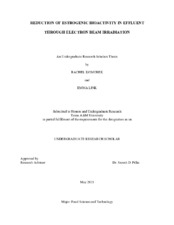| dc.creator | Komorek, Rachel Elise | |
| dc.creator | Link, Emma C. | |
| dc.date.accessioned | 2017-12-11T21:51:22Z | |
| dc.date.available | 2017-12-11T21:51:22Z | |
| dc.date.created | 2015-05 | |
| dc.date.issued | 2014-09-19 | |
| dc.date.submitted | May 2015 | |
| dc.identifier.uri | https://hdl.handle.net/1969.1/165483 | |
| dc.description.abstract | Clean water availability has been made scarce by droughts in Texas caused by longer and hotter summers. Therefore, adopting new water reuse strategies has become important. A concern with recycled water has been the increase of emerging contaminants such as pharmaceuticals and chemicals, specifically estrogenic compounds, due to industrialization. Over exposure to exogenous estrogenic compounds has been shown to lead to cancers and diseases such as reproductive disorders. These adverse health effects can occur in humans and animals when estrogens are not effectively removed from wastewater effluent during water reclamation processes. Electron beam (eBeam) irradiation is an environmentally friendly technology that utilizes high energy electrons to yield rapid reduction and oxidation reactions, and has been shown to break down estrogens in wastewater biosolids. Our hypothesis is that estrogenic compounds, estrone (E1), 17-β-estradiol (E2), and bisphenol A (BPA), can be effectively broken down in wastewater effluent using eBeam irradiation. Should the estrogens be broken down, they will no longer be bioactive and capable of causing adverse health effects. The reduction in bioactivity of the estrogen was quantified using a yeast estrogen screening assay (YES assay) after eBeam irradiation of wastewater effluent at doses between 2 kGy and 15 kGy. The detection limits of the YES Assay were 25pM for E1 and E2 and 0.25pM for BPA. Reduction was seen in E2 at an absorbed dose of 15kGy. However, reproducible reduction of estrogenic bioactivity for E1 and BPA could not be determined from irradiation trials. The YES Assay was originally developed with E2 and therefore it is possible that it is not an optimal assay to detect reduction in bioactivity for E1 and BPA. Overall we are not able to conclude that eBeam irradiation is an effective reduction method for the estrogens in wastewater effluent, and further studies are needed to confirm our hypothesis. | en |
| dc.format.mimetype | application/pdf | |
| dc.subject | electron beam irradiation | en |
| dc.subject | estrone | en |
| dc.subject | E1 | en |
| dc.subject | 17-B-estradiol | en |
| dc.subject | E2 | en |
| dc.subject | bisphenol A | en |
| dc.subject | BPA | en |
| dc.subject | yeast estrogen screening assay | en |
| dc.subject | YES assay | en |
| dc.subject | water reuse | en |
| dc.subject | water reclamation | en |
| dc.subject | estrogenic activity | en |
| dc.title | Reduction of Estrogenic Bioactivity in Effluent through Electron Beam Irradiation | en |
| dc.type | Thesis | en |
| thesis.degree.department | Nutrition and Food Science | en |
| thesis.degree.discipline | Food Science & Tech. | en |
| thesis.degree.grantor | Undergraduate Research Scholars Program | en |
| dc.contributor.committeeMember | Pillai, Suresh D | |
| dc.type.material | text | en |
| dc.date.updated | 2017-12-11T21:51:22Z | |


